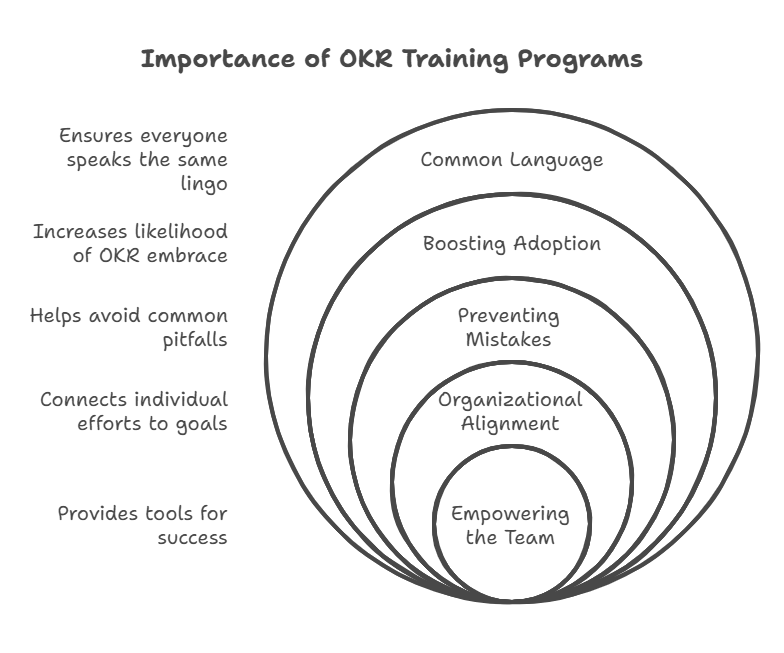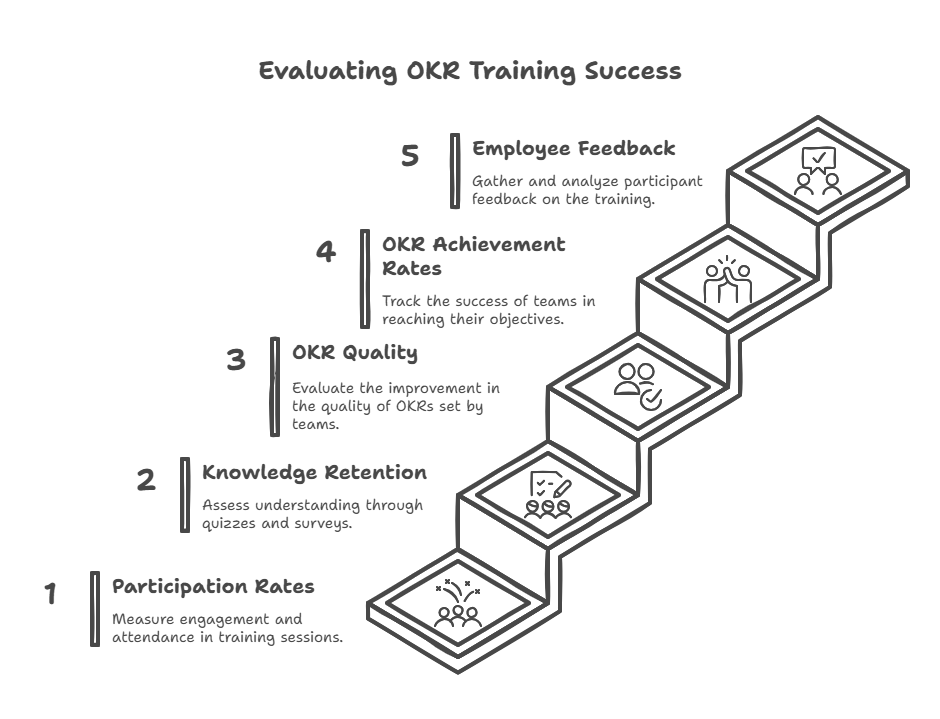Introduction
Hey there, OKR enthusiasts! So, you’ve decided to implement OKRs (Objectives and Key Results) in your organization. Great choice! But now you’re facing a new challenge: how do you get everyone on board and up to speed? Enter OKR training programs. These aren’t just boring seminars where people doze off – they’re your secret weapon for turning your team into OKR ninjas. In this article, we’re going to dive into the world of OKR training programs. We’ll explore why they’re crucial, what they should cover, and how to create a program that’ll have your team setting and crushing objectives like pros. Whether you’re a startup founder, a HR manager, or just an OKR enthusiast, this guide will help you create a training program that rocks. Let’s get started!
Why OKR Training Programs Matter

Before we jump into the nitty-gritty, let’s talk about why OKR training programs are such a big deal. Here’s the scoop:
- They create a common language: OKRs have their own lingo. Training ensures everyone’s speaking the same language.
- They boost adoption: People are more likely to embrace OKRs if they understand them.
- They prevent common mistakes: Good training helps teams avoid pitfalls that can derail your OKR efforts.
- They align your organization: Training ensures everyone understands how OKRs connect individual efforts to company goals.
- They empower your team: Knowledge is power. OKR training gives your team the tools they need to succeed.
Key Components of an Effective OKR Training Program
Alright, let’s break down what your OKR training program should cover:
1. OKR Basics
Start with the fundamentals. Cover topics like:
- What are OKRs?
- The difference between Objectives and Key Results
- The history and philosophy behind OKRs
2. OKR Best Practices
Move on to the how-to’s. This might include:
- How to write effective Objectives
- Crafting measurable Key Results
- The art of setting ambitious but achievable goals
3. OKR Cycle and Process
Explain how OKRs work in practice:
4. Alignment and Cascading
Show how OKRs connect across the organization:
- Aligning individual OKRs with team and company objectives
- The concept of cascading OKRs
- Balancing top-down and bottom-up goal setting
5. Common Pitfalls and How to Avoid Them
Prepare your team for challenges:
- Avoiding “set and forget” syndrome
- Not tying OKRs to performance reviews or bonuses
- Dealing with changing priorities mid-cycle
6. OKR Tools and Resources
Introduce the tools and resources available:
- OKR tracking software (if you’re using any)
- Templates for setting and scoring OKRs
- Where to find help and support
Designing Your OKR Training Program
Now that we know what to cover, let’s talk about how to design a killer OKR training program:
1. Know Your Audience
Tailor your training to your audience. Executives might need a high-level strategic view, while team leads might need more hands-on practice in setting OKRs.
2. Mix Up Your Methods
People learn in different ways, so use a variety of training methods:
- Interactive workshops
- E-learning modules
- Video tutorials
- Hands-on exercises
- Case studies and real-world examples
3. Make It Engaging
Let’s face it, training can be boring. Spice things up with:
- Group activities and discussions
- Gamification elements (OKR bingo, anyone?)
- Real-life examples and stories from your organization
4. Provide Ongoing Support
Training shouldn’t be a one-and-done deal. Offer ongoing support through:
- Regular refresher sessions
- An OKR help desk or champion
- A library of resources (articles, videos, templates)
5. Practice, Practice, Practice
The best way to learn OKRs is by doing. Include plenty of opportunities for hands-on practice in your training program.
Implementing Your OKR Training Program
You’ve designed an awesome program. Now let’s talk about rolling it out:
1. Start at the Top
Begin your training with leadership. Their buy-in and understanding are crucial for success.
2. Train in Waves
Don’t try to train everyone at once. Start with a pilot group, gather feedback, refine your program, and then expand.
3. Make It Mandatory (But Fun!)
OKR training should be required, but that doesn’t mean it has to be a chore. Make it an event people look forward to.
4. Gather and Act on Feedback
Continuously improve your training program based on participant feedback. What’s working? What’s not? Adjust accordingly.
5. Celebrate OKR Wins
Use your training sessions to highlight OKR success stories from your organization. It’ll help make the concepts more tangible and motivating.
Measuring the Success of Your OKR Training Program

How do you know if your training is working? Here are some metrics to track:
- Participation rates: Are people showing up and engaging?
- Knowledge retention: Use quizzes or surveys to test understanding.
- OKR quality: Are teams setting better OKRs after training?
- OKR achievement rates: Are teams more successful in reaching their objectives?
- Employee feedback: What do participants say about the training?
Conclusion
Whew! We’ve covered a lot of ground, haven’t we? OKR training programs are more than just a box to check – they’re a crucial part of your OKR implementation strategy. A well-designed training program can be the difference between OKR success and failure. Remember, the goal isn’t to create OKR experts overnight, but to start a journey of continuous learning and improvement.
Key Takeaways:
- OKR training programs are essential for successful OKR implementation.
- Effective programs cover OKR basics, best practices, processes, alignment, common pitfalls, and available tools.
- Design your program with a mix of methods to cater to different learning styles.
- Start training at the top and roll out in waves, gathering feedback as you go.
- Measure the success of your training program and continuously refine it.
Frequently Asked Questions
- How long should our OKR training program be?
The length can vary, but a good starting point is a half-day to full-day initial training session, followed by shorter, regular refresher sessions. Remember, OKR learning is ongoing! - Should we develop our training in-house or bring in external experts?
Both approaches have merits. In-house training can be more tailored to your organization, while external experts bring broader experience. Many companies use a mix of both. - How do we handle resistance to OKR training?
Address concerns head-on. Often, resistance comes from misunderstanding or fear. Emphasize the benefits of OKRs and how the training will make people’s work lives easier and more impactful. - Can OKR training be done remotely?
Absolutely! While in-person sessions have benefits, many organizations successfully conduct OKR training remotely using video conferencing and online collaboration tools. - How often should we update our OKR training program?
Review and update your program at least annually, or more frequently if you’re getting consistent feedback about areas for improvement. OKR best practices evolve, and your training should too!
Further Reading
- “Measure What Matters” by John Doerr
- “Radical Focus: Achieving Your Most Important Goals with Objectives and Key Results” by Christina Wodtke
- “The Beginner’s Guide to OKR” by Felipe Castro (available online)
- “OKRs: How to Set Them Up to Drive Growth” by Sven Winter (available on Medium)
- “Introduction to OKRs” by Felipe Castro (available online)


